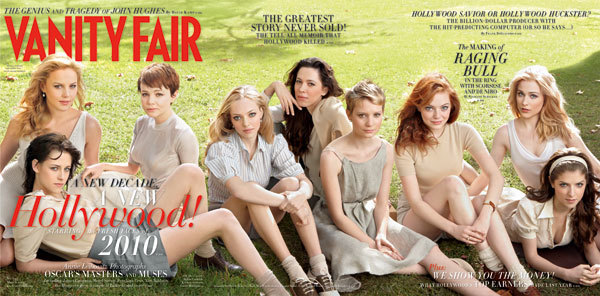
What Female Journalists Really Care About XLIV
02/08/2010
There’s always the Washington Post’s XX featurette for heaping mounds of Taking Everything Personally:
To Be Young, Gifted, and White in Hollywood
The blogosphere is a-twitter about Vanity Fair’s latest “New Hollywood” cover. Specifically, its stark lily-whiteness. As Dlisted put it, this year’s annual Annie Leibovitz shot “makes a BYU class picture look like a Benetton ad.”
Bloggers have pointed out a few obvious, non-white actresses who could have been included, like Gaby Sidibe, who is featured in the portfolio inside the magazine, but not on the cover.
The star of Precious weighs 300 pounds. No woman is going to be drawn to make an impulse purchase of a fashion and lifestyle magazine because there’s a 300 pounder on the cover.
There’s also Zoe Saldana, who starred in the two biggest sci-fi movies of the year, Star Trek and Avatar.
This Dominican-American is really good in Avatar as Manute Bol’s big blue sister, or whatever she’s supposed to be. On the other hand, would anybody who saw her in Avatar recognize her?
Nobody gives credit to acting performances in special effects blockbusters, but it’s probably technically harder to act well in a huge movie than in a low budget film where you get to act with other people and do more lines per day on the set. A big challenge in acting is adrenaline management. It’s easiest in the theater where you just have to be on from 8 to 10pm each evening. You can arrange your day to peak then. It might be hardest in technically complicated films where its hard to foresee when they'll finally be ready for you back on the set after a long day of the crew twiddling with technology. On the other hand, maybe part of Cameron’s new techniques are ones to make it easier on actors?
Yes, Saldana was featured on the cover of the 2008 Hollywood issue–behind the gatefold, natch, along with Alice Braga and America Ferrera–but then, they put ScarJo on the cover of the Hollywood issue THREE YEARS in a row. (2004, “05, and “06.) And can I make a retroactive vote for Charlyne Yi? Admittedly, I don’t think she glams up all that often, but the prospect is so delicious.
Hmmhmm, why would Nina Shen think Charlyne Yi should be put on magazine covers?
Try to play this game too long, though, and you run out of steam. After all, as Dodai Stewart points out on Jezebel, it’s not as if Hollywood is exactly teeming with hotly-tipped [excuse me?] young actresses of color. Maybe it’s just a numbers thing, and those of us who feel angry at VF really are just shooting the messenger. Most American movie ing?©nues, after all, are white, pretty, and thin. But it’s a chicken-and-the-egg kind of scenario. Is Hollywood to blame for not putting more actresses of color in its movies? Or are magazines like VF to blame for perpetuating the idea that young, worthy actresses are naturally thin, pretty, and Ivory soap-white?
Or maybe the overseas market, which now accounts for a large majority of American box office, is to be blamed? Maybe the Japanese, the world’s #2 movie market, just like looking at Scarlett Johansson more than they like looking at Charlene Yi? (And in foreign markets where American films are dubbed into the local language, audiences don’t have to listen to Scarlett’s grating voice.)
Or maybe actresses of color should be blamed for not being, on average, glamorous and talented enough to sell as many movie tickets? Nah, by definition, it couldn’t be that!
As momentarily satisfying as it feels, I also don’t feel entirely comfortable cherry-picking actresses of color and then waving them around, yelling, “Here’s one you could have put in there!” It makes it sound like we’re pushing for a kind of tokenism, some quota-based notion of “diversity,” when really it’s just sad that someone could look at an image like that and not see race written all over it.I was chatting with a friend about the brouhaha today, and she was reminded of this line in Adam Gopnik’s recent New Yorker obit of J.D. Salinger:
In American writing, there are three perfect books, which seem to speak to every reader and condition: “Huckleberry Finn,” “The Great Gatsby,” and “The Catcher in the Rye.”Now, I happened to hate The Catcher in the Rye, and The Great Gatsby left me cold when I finally read it, years and years after I should have. So maybe Gopnik and I have different literary tastes. That’s all fine and good; I’m not obligated to buy his assertion that these are “perfect” novels. But the notion that these books should “speak” to me and my “condition”–that I will naturally find something resonant and familiar in the experiences described therein–makes me feel strangely claustrophobic. (And I can only imagine what a black person who finds Huck Finn deeply problematic is supposed feel.) It’s not that I think Gopnik should have added some books with minority characters to that short list. It’s just upsetting to be reminded that “white and male” is still seen as some kind of universal solvent–a category that everyone else can be dissolved into.
Damn white males have just written too many good books. After such knowledge, what forgiveness?
